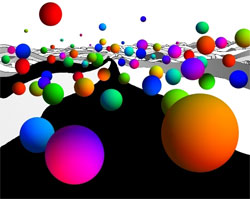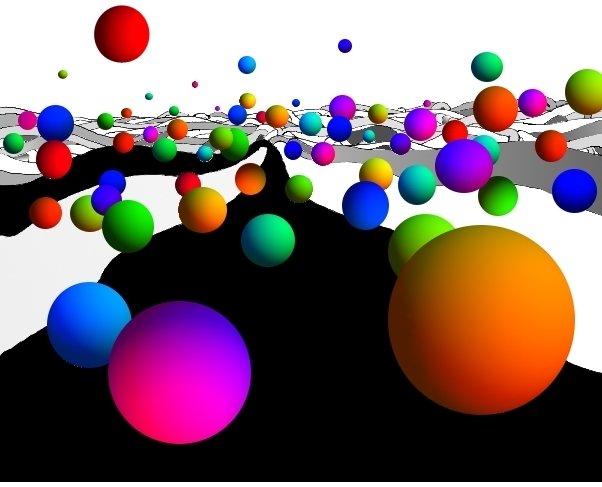Quark Colors Unbound
In the minds of theorists, quarks come in a rainbow of different colors. Although experiments clearly indicate that there are just three types of “charge” (color) for quarks interacting through the strong nuclear force, calculations become much simpler when the number of colors is very large. Computer simulations described in the 5 December Physical Review Letters strengthen the case that multi-color theories provide roughly the same predictions as the three-color theory. The paper also shows that one class of these models derived from string theory makes predictions that closely match the results computed in simulations using the three-color theory.
In the theory of quark interactions, called quantum chromodynamics or QCD, quarks have a property called color that is analogous to charge in electromagnetism. The theory is complicated by the fact that the particles that bind quarks together–the gluons–also carry a color. This means that any calculation has to account for not only quark-gluon interactions but also gluon-gluon interactions. In 1974, Nobel laureate Gerard ‘t Hooft of Utrecht University in the Netherlands claimed that one could effectively reduce the strength of some of these interactions–and thereby make QCD more tractable–by arbitrarily increasing the number, N, of color charges. Theorists have used the “large-N limit” to derive analytical results for quantities such as the viscosity and conductivity inside a hot mixture of quarks and gluons, which would be very hard to do using N = 3.
Large-N theories are not only attractive for their mathematical simplicity; they may also provide a deeper understanding of quark behavior, says Marco Panero of the Swiss Federal Institute of Technology (ETH) in Zürich. The trouble is there’s no proof that they accurately represent real-world QCD. So Panero–like others before him–ran computer simulations to check what happens as N is allowed to increase. He examined a wider temperature range than previous simulations, and he compared them with a specific large-N theory.
Specifically, Panero simulated the interactions of a large number of gluons at temperatures above 2 trillion degrees Kelvin (200 MeV) as would have occurred in the first microseconds after the big bang. He left out the quarks that would have been present because their contribution turns out to be negligible as N increases. Letting N equal 3, 4, 5, 6 and 8, he computed the pressure, entropy, and energy density over a wider range of temperatures than has previously been looked at. The results were practically the same for all N, confirming that large-N models should be predictive in this regime.
As a case in point, Panero examined certain large-N models derived from string theory. These are based on the so-called AdS/CFT correspondence, the decade-old idea that a large class of string theories of gravity can be transformed directly into highly symmetric field theories that partly resemble QCD. Calculations on the string side of this correspondence are relatively easy to perform, and then the results can be converted into field theory language. But it is debatable just how “QCD-like” the field theory side is. Panero showed that the QCD thermodynamic predictions from one AdS/CFT-inspired model [1] matched his own simulations nearly perfectly.
Igor Klebanov of Princeton University isn’t sure how significant this agreement is, considering that the chosen model has adjustable parameters that help bring it in line with QCD. However, he says that Panero’s simulations of the entropy density seem to indicate that string-based models are on the right track. “Strings are showing that they can be useful” for performing calculations, Klebanov says, which could be a sign that they play a more fundamental role in describing the particles and forces of nature.
–Michael Schirber
Michael Schirber is a Corresponding Editor for Physics Magazine based in Lyon, France.
References
- U. Gürsoy, E. Kiritsis, L. Mazzanti, and F. Nitti, “Deconfinement and Gluon Plasma Dynamics in Improved Holographic QCD,” Phys. Rev. Lett. 101, 181601 (2008); U. Gürsoy, E. Kiritsis, L. Mazzanti, and F. Nitti, “Improved Holographic Yang-Mills at Finite Temperature: Comparison with Data,” Nucl. Phys. B 820, 148 (2009)





